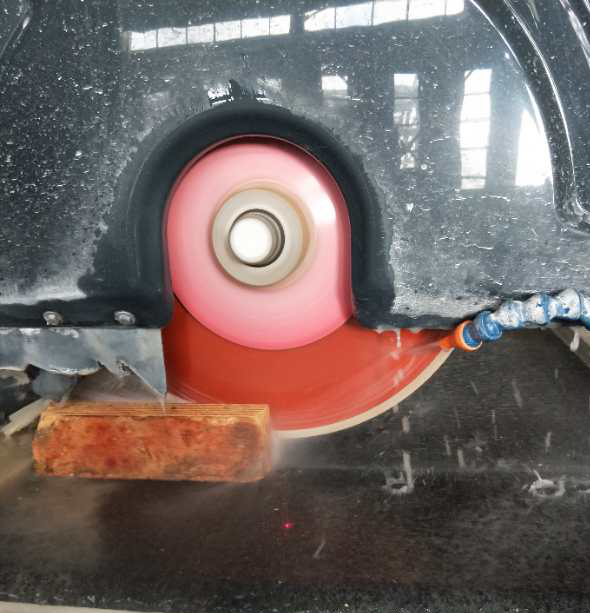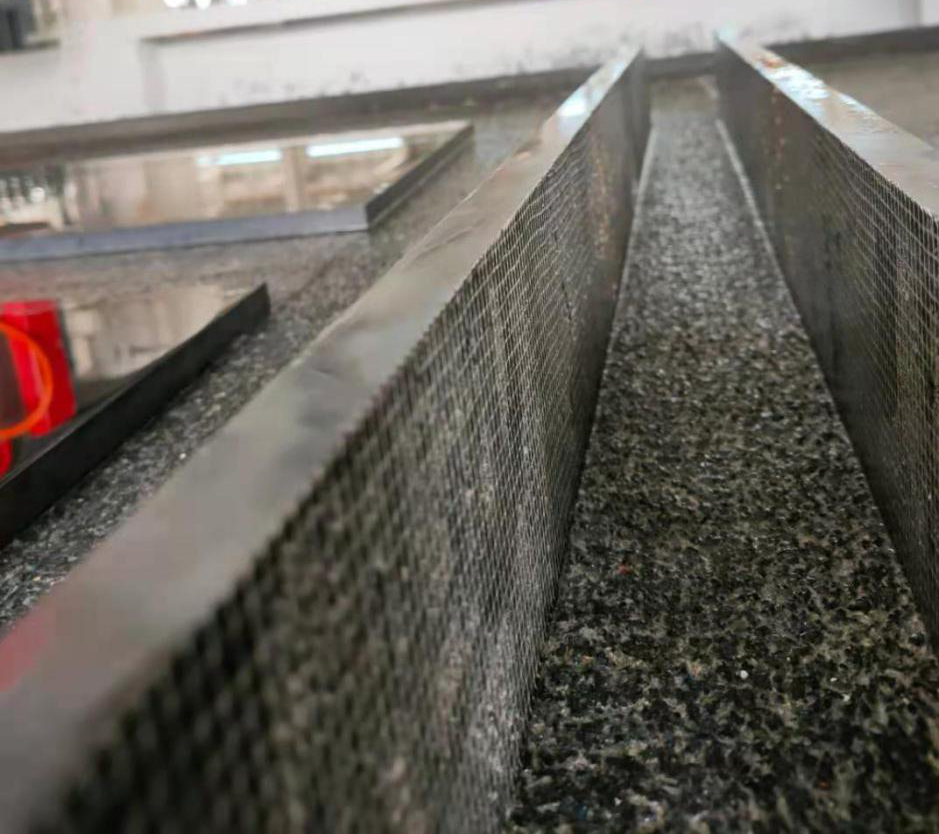News
联系我们
泉州达锋机械有限公司
手机:18959735709 (微信同号)
地址:福建省南安市水头镇海联创业园工业大道25号
Industry News
The stone cutting board has chipped edges and corners? Maybe you didn’t sharp your knife
时间:2021-01-11 09:27:52 来源: 总浏览:1019 字体:16px | 14px | 12px
Many people understand the meaning of the idiom "knife sharpening and not cutting firewood by mistake", but not many people really apply it to actual work.
The idiom "knife sharpening does not accidentally cut firewood" means that although sharpening the knife will take some time, it does not delay cutting firewood. The knife is sharp, cutting firewood faster and more efficient. The deeper level metaphor of "sharpening the knife without accidentally cutting firewood" fully prepares in advance, can speed up the work and improve the quality of the work.
In the stone production and processing, the saw blade of the bridge cutting machine cutting board not only needs to be sharpened, but also sharpened during use.
After the saw blade is used for a period of time, with the wear of the saw blade, the sharpness of the saw blade decreases, the efficiency of the cutting board is significantly reduced, the quality of the cutting board is also poor, and the sound of spikes is emitted.
The new saw blade can cut more than 100 square slabs a day, and the saw blade can only cut more than 80 square slabs after a period of use. Sometimes the output is lower, and it cannot cut some high-hardness stone saw blades. If it is forced to cut, the saw blade There will be sparks, sharp spikes, and sometimes even lift up the material on the workbench; as the sharpness of the saw blade decreases, the cut board is also terrible, and the front edge of the board collapses and corners. The edges are jagged; the bottom edge is very ugly like a dog chewing.
When this situation occurs in the cutting board, people who understand the cause of the problem will find refractory bricks to "sharp" the blade of the saw blade, improve the sharpness of the saw blade, and eliminate the dullness of the saw blade. People who don’t understand this principle will allow this phenomenon to continue, cutting materials slowly, the production efficiency is low, and the quality of the cut sheet products is poor, until the saw blade is really unable to cut, and there is still at the height of the saw blade. In many cases, the saw blade can be replaced while the saw blade is still in use, resulting in waste of the saw blade.
I have experienced such a thing. The factory order cutting board is urgent, and several bridge cutting machine cutting board outsourcing staff are invited to the factory to cut gold hemp and Yabai jade boards, and cut the board overnight to check the progress of the cutting board. In the case, a large number of missing edges and corners of the board and jagged edges on the surface are seen. Asked why the board cut out by the outsiders is so bad?

Their reason is that these two materials Yabai jade has high hardness, many surface cracks, and high brittleness. It is easy to collapse and drop corners. Although golden hemp is a granite material, the material is loose, granular, and has a litchi surface. The corners of the cutting board are easy to fall off, and the appearance of jagged edges on the surface is inevitable. Ask the outsiders if they have sharpened their knives after cutting overnight. They were silent.
The outsourcing staff only emphasized the reasons for the edges and corners from the objective conditions of the materials, and did not find the responsibility from their own subjectivity. During the cutting process, they did not sharpen the knife under the condition that the saw blade is not sharp. They only drove at high speed. The saw blade cuts more output (because the outsourcing staff is pure piecework, and the income is higher), how can they cut good quality boards? This is the real reason why there are many chippings, corners, and jagged edges in the cutting board of the outsiders. Figure 1 shows the chipping of the bottom surface of the board caused by the saw blade is not sharp.
Regardless of the saw blade produced by the saw blade factory, as the use time of the saw blade increases, the wear increases, the saw blade will be sharper, and there is no need to sharpen the blade, especially for cutting high-hardness marble, granite, and quartz stone. When slab, the sharpness drops faster. Some hard stones even cut one or two large slabs to sharpen the knife to improve the sharpness of the saw blade. There are inherent factors in the reduction of saw blade sharpness during use:
No matter what kind of diamond circular saw blade, whether it is imported or domestically produced, it will be subjected to alternating loads such as centrifugal force, sawing force, and sawing heat during the stone cutting process. These forces make the saw The abrasion and sharpness of the pieces continue to decrease, and the harder the stone is more obvious, the sharpness decreases faster. Due to the force effect and temperature effect, the diamond circular saw blade is worn and destroyed.
The temperature effect believes that the influence of temperature on the saw blade process is mainly manifested in two aspects:
One is to cause graphitization of diamond in agglomerates;
The second is the thermal stress between the diamond and the matrix, which causes the diamond particles to fall off prematurely.
The heat generated in the cutting process is mainly transferred to the cutter head, and the temperature in the center of the cutter head is not high, generally between 40 and 120°C. The grinding point temperature of the abrasive grains is higher, generally between 250 and 700°C. The coolant only lowers the average temperature of the cutter head, and has little effect on cooling abrasive particles. Such a temperature will not cause the diamond graphite to be carbonized, but will change the friction properties between the abrasive particles and the workpiece, and cause thermal stress between the diamond and the bonding agent, which will lead to a fundamental change in the failure mechanism of the diamond.

The temperature effect is the biggest factor influencing the damage of the saw blade. Effective cooling is the prerequisite to avoid the temperature effect. At the same time, the appropriate saw blade line speed, sawing depth, and feed speed should be adjusted according to the nature of the stone.
Abrasion damage: due to the force effect and temperature effect, the saw blade will often be worn and damaged after a period of use. There are five manifestations of wear and damage: abrasive wear, partial crushing, large area crushing, shedding, and bonding agent along the sawing direction. Mechanical scratches.
Abrasive wear: The diamond particles are constantly rubbing against the workpiece, the edges are passivated into a plane, the cutting performance is lost, the friction is increased, and the heat of sawing will cause a graphitized layer on the surface of the diamond particles, which greatly reduces the hardness of the diamond, which intensifies wear;
Partial crushing: The surface of diamond particles is subjected to alternating thermal stresses and also subjected to alternating cutting stresses. Fatigue cracks will appear and local breakage will appear, revealing sharp new edges. This is an ideal wear pattern for large-area breakage. The diamond particles are subjected to impact load when cutting in and out, and the alternating cutting force causes the diamond particles to be swayed in the bond continuously to loosen, and the more prominent particles and crystal grains are consumed prematurely and fall off;
Shedding: The wear of the bond itself and the heat of sawing during the sawing process soften the bond, which reduces the holding force of the bond. When the cutting force on the particles is greater than the holding force, the diamond particles will fall off. No matter what kind of wear is closely related to the load and temperature of the diamond particles. The diamond particles on the surface of the saw blade continue to fall off, and more diamond particles are exposed by sharpening the blade to improve the sharpness of the saw blade.
It is precisely because the saw blade is affected by the unavoidable external force in the process of cutting the stone, the saw blade will not become sharper and more blunt, and the efficiency of cutting board will be greatly reduced as the saw blade becomes blunt. The quality is getting worse. To improve efficiency and improve the quality of the cutting board, the only way to stop the cutting board is to sharpen the saw blade with refractory bricks, so that the emery wrapped in the carcass is exposed, the sharpness of the saw blade is improved, and the performance of the saw blade is restored.
Many colleagues in the production management work have encountered such a problem: Bridge cutting employees or machining employees will find you and say: Leaders, how can the saw blade not move, do not cut a few square boards in a day; how do leaders cut today Many of the slabs have broken edges and corners, and the diagonal is not good; the saw blades leading this company are not good, not sharp, and can't cut this kind of stone at all. Change your saw blades!
In fact, the reasons for these problems are mostly because the users of the saw blade do not know that the saw blade needs to be sharpened during the use of the saw blade. They only regard the saw blade not to cut as a problem of the quality of the saw blade. When these problems occur, just take a moment to sharpen the knife with refractory bricks. The sharpness of the saw blade can be greatly improved and improved, and the quality and efficiency of the cutting board have also been improved.
The sharpening of the saw blade seems to be a trivial matter, but it is also a trivial matter that cannot be underestimated in the production and processing, because a broken board is money, which will affect the normal production.
We can often see that the slabs cut by some stone companies have no cracks or corners from the surface to the back. The surface quality of the slabs is very beautiful and the verticality of the slabs is good. The surface quality of the slabs cut by some stone manufacturers There are many edges and corners, the appearance of the board is of poor quality, and the verticality of the board is not good. A large part of the reason is whether the sense of responsibility of the employees during the cutting process is to find the cause and solve the abnormality in the cutting process. These abnormal problems include judging whether the saw blade needs to be sharpened.
Qualified bridge cutters immediately sharpen the blade when the saw blade is not sharp to improve the sharpness of the saw blade. Although it took a little time, the saw blade is sharpened, the speed and efficiency of the cutting board are improved, and the quality of the cutting board Even better, I am so happy that I have gotten twice the result with half the effort!



